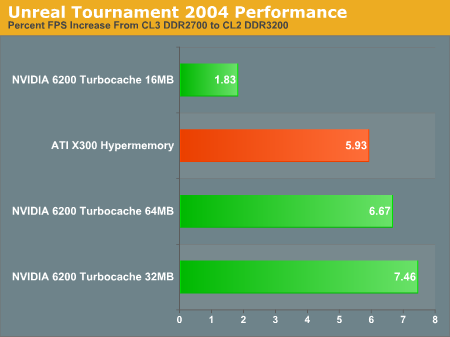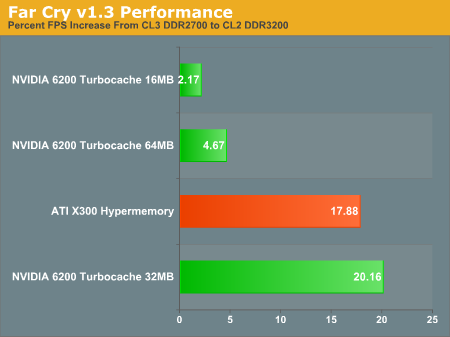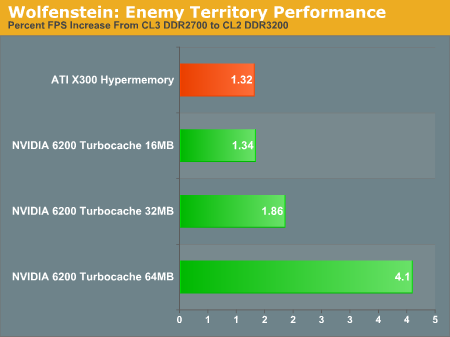Budget Graphics Strike Back: Revenge of the RAM
by Derek Wilson on May 19, 2005 5:40 AM EST- Posted in
- GPUs
DDR333 3:4:4:12 Graphics Performance
After we saw the results for our CL3 PC3200 tests, we wondered what would happen if we plugged in some even slower, lower bandwidth PC2700. Using 3:4:4:12 2T timings with our 333MHz data rate RAM, we pushed the budget factor even further. The format is the same as our previous section, showing performance increase when moving from the slower RAM to our fastest.With this test, we see results that vary more per game. Doom 3 and Half Life 2 show that TurboCache cards with more RAM suffer less from slow system memory. UT2K4 and Wolfenstein put the lower memory cards on top of the 64MB card.















21 Comments
View All Comments
Calin - Thursday, May 19, 2005 - link
I pretty much prefer an integrated graphics to one of those cards - but there are some problems:1. you can easily change the graphic card, much easier than changing the mainboard
2. I want a integrated graphics mainboard. There are almost no mainboards I can buy (or they are not available here)
3. To compare to the performance of a card with local memory plus system memory, the integrated card must have a local memory also (frame buffer or whatever)
AtaStrumf - Thursday, May 19, 2005 - link
Damn it Calin, you already fixed the timings, so my copy/pasted statement is inconsistent with what's in the graph and what I was saying. I was referring to: Percent FPS **increase** from 2:2:2:8 to 3:4:4:12 line in the first graph on page 2 and the same thing is repeated in other graphs as well. You can either change the order of timings or "increase" to "decrease". Your pick, but I prefer decrease, because it's more logical that way.AtaStrumf - Thursday, May 19, 2005 - link
Yea I mean really: Percent FPS increase from 3:4:4:12 to 2:2:2:8. And then the least increase get puts a card at the top? WTF?!?! You gotta be kidding right. I believe it should be decrease.Anyway, who cares, if you get a card like this, you are not gonna be playing games much, and even then I'd like my RAM to stay intact. If I want to share my system RAM with a GPU, I'll get one integrated in a chipset, thank you very much.
Just one more marketing BS scheme.
Houdani - Thursday, May 19, 2005 - link
[quote]"Upon examination, the graphs reveal counterintuitive data."
[/quote]
Heh, it's particularly counterintuitive since the page 2 graph titles are backwards! See #5, above.
Tarumam - Thursday, May 19, 2005 - link
I think th ewhole concept of both turbocache and hypermemory is wrong. I mean if you have a system with a very cheap dedicated video card on it, that´s because two main reasons:1- You don´t care much about 3d performance;
2- You don´t want the video subsystem wheighing on the ram memory.
Those reasons all but completely disaprove the use of a weak dedicated GPU that will use the main system memory.
Anyways, thanks for the article as it demonstrates that there are no such things as miracles. The bottom line is: If you´re going to build me a computer with the video subsystem in a dedicated video card, then (whatever the budget you have for it) keep it off my RAM.
BornStar18 - Thursday, May 19, 2005 - link
I agree with #5. That's my only grievance so far.Calin - Thursday, May 19, 2005 - link
On the second page, the graphics should read "Percent FPS increase from 3:4:4:12 to 2:2:2:8" - assuming the performance is better with fast memory.What processors did you use in the test? At that time, for Pentium4 only dual channel solutions are easy to grab, however, Athlon64 single channel (Socket 754) is pretty common and a much more sensible choice for a budget computer.
mostlyprudent - Thursday, May 19, 2005 - link
Sorry if I missed this in this or the previous article, but how does the performance of the ATi 32MB Hypermemory card compare to the standard X300 with 128MB of onboard memory?Iftekharalam - Thursday, May 19, 2005 - link
Look at the Farcry 1.3 Performance benchmark. The system memory causes the frame rate to fluctuate up to 20%!Iftekharalam - Thursday, May 19, 2005 - link
My first post in anandtech becomes the 2nd post!